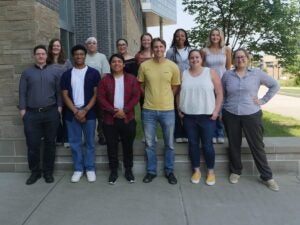Assistant Professor Katharina Quinlan is principal investigator on new research that could repurpose existing therapeutics as a way to treat cerebral palsy.
Updated September 9, 2023
New research could help shed light on why cerebral palsy develops, and also repurpose existing therapeutics to treat the disorder.

Katharina Quinlan, an assistant professor of biomedical and pharmaceutical sciences at the Ryan Institute, is principal investigator on three new grants, totaling $8.5 million, to investigate key questions in cerebral palsy––a disorder that affects movement, posture, and balance. One of the grants is a collaboration with Marin Manuel, also an assistant professor of biomedical and pharmaceutical sciences at the Ryan Institute.
Spastic cerebral palsy is the most prevalent type of cerebral palsy. Caused by injury (such as lack of oxygen or infection) to the developing motor cortex and pathways, it is characterized by movement dysfunction such as muscle spasms, stiffness, or weakness. It is estimated to affect between 1 and 4 out of 1,000 births worldwide.
An Over-the-Counter Alternative
Quinlan had been curious for years about something called primary afferent depolarization, also known as “PAD,” a mechanism that causes a reflex response to vary depending on sensory input. (The knee-jerk you experience sitting on the examining table at the doctor’s office, for example, would not be the same if the doctor tapped on the same spot while you were in motion.)
Quinlan wondered: Considering that PAD helps to shape this reflex response, what role does it play in cerebral palsy, which can cause spastic or exaggerated reflex responses? But she found that PAD had never been studied in this context.
On a five-year, $2.8 million grant, she will investigate PAD in cerebral palsy, along with an intriguing idea: the potential to use transcutaneous electrical nerve stimulation (TENS) to help modulate hyperactive reflexes that can cause spasms through the PAD mechanism. An over-the-counter, low-voltage device, TENS is widely used to treat pain by manipulating the user’s sensory input to interfere with their pain perception.
As opposed to invasive treatments, Quinlan is investigating whether using TENS to tweak sensory input could be an affordable and accessible way to reduce spasms.
“In spastic cerebral palsy, there is too much afferent input,” says Quinlan. “A common treatment is to surgically sever afferents. This reduces spasticity, but it can also cause the loss of sensation or certain functions. Using TENS would be a way to dampen the afferent input without surgically cutting nerve fibers.”
The grant includes collaborators at the University of Alberta and the University of Saskatchewan in Canada, and University of Brescia in Italy.
A Serotonin-Based Therapy
While hypertonia, a condition where too much muscle tone causes joint stiffness and difficulty with movement, is common in cerebral palsy, little is known about why this condition develops. However, Quinlan and colleague Marin Manuel are focused on a potential clue.

Many people know serotonin as a neurotransmitter related to feelings of happiness, but it also plays a critical role in brain development and spinal cord function.
In recent work, Quinlan saw that motor neurons—cells that enable us to carry out movement—become excessively active in response to serotonin following an injury such as prenatal hypoxia, or lack of oxygen, which is a cause of cerebral palsy. “We saw that the serotonergic neurons actually flourish and sprout even more, releasing more serotonin into the spinal cord,” said Quinlan. Further research showed that an influx of serotonin alone could cause hypertonia, even without hypoxic injury.
She shared these findings with colleague Marin Manuel, whose work examines the deterioration of spinal neurons and networks in movement disorders. This led to their hypothesis that blocking serotonin after hypoxia could prevent hypertonia from developing.
On a five-year, $3 million grant, the team will investigate whether—and how—a serotonin antagonist could be used as a potential treatment.
“Blocking serotonin during development is difficult because even if you block the maternal source, it is also produced by the placenta and embryo, as early as nine weeks into development,” said Quinlan. “In cases of traumatic birth, we want to try to identify a critical point when a serotonin antagonist might be able to prevent hypertonia.”
The project includes the key step of identifying which serotonin receptors in the spinal cord are the ones that contribute to spasticity and hypertonia. “Serotonin plays so many roles, we don’t want to block all of it,” said Quinlan. “The idea is to look at a very targeted treatment that could be delivered specifically to the spinal cord.”
Quinlan cites Manuel as a particular asset to the project. The Manuel lab is unique for its ability to record motor neuron activity simultaneously with muscle output in a live animal model—critical for identifying which motor neurons correspond with which muscle activity. “I think Marin’s technique will be transformational to knowing what is going on in muscle development in cerebral palsy,” said Quinlan.
Although it is not a goal of the research, the project could also shed light on the safe use of serotonin reuptake inhibitors for women during pregnancy. (Commonly referred to as SSRIs, serotonin reuptake inhibitors allow for greater availability of serotonin in the brain and spinal cord. SSRIs are commonly used to treat depression and other mental health conditions.)
Quinlan hopes that her research, which includes an additional $2.7 million NIH grant awarded in September to study pain in cerebral palsy, will lead to new hope for improved cerebral palsy treatments and prevention.
“Treatments for cerebral palsy can be invasive yet ineffective,” said Quinlan. “Our goal is to find a potential treatment that could translate to humans, where babies at risk could be treated for cerebral palsy before their nervous system matures in a dysfunctional way.”
